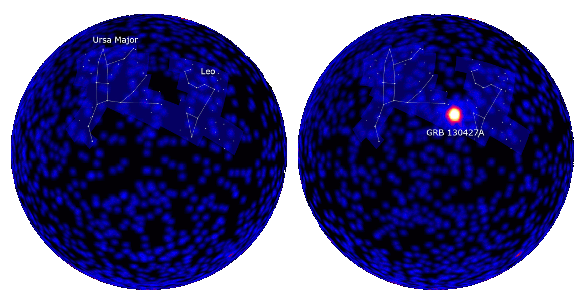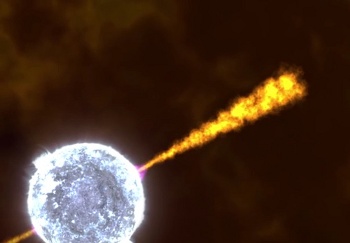Gamma-Ray Burst GRB 130427A
December 11, 2013
Humans are fragile
organisms whose
natural environment is all but benign. Even the
air we breath is dangerous, since it contains the
radioactive gas,
radon, a product of the
decay of
uranium isotopes in
minerals. I reviewed environmental radon in a
previous article (Radioactive Fountains of the Deep, March 29, 2012), but there are other sources of
background radiation.
If we're feeling
paranoid, it might be because the
universe really is trying to get us. Along with the radon attacking us from below, the universe is bombarding us with
cosmic rays. Energetic
nuclei and
electromagnetic radiation from various cosmic sources impinge on
Earth's atmosphere, where they interact with the nuclei of air
molecules to create radiation that reaches Earth's surface. The
lower atmosphere shields us from some of this, but frequent
air travelers get a higher
dose.
Aside from these usual radiation sources, there are infrequent radiation events of high intensity, some of which are
gamma ray bursts. Although a detailed
mechanism for the generation of these gamma ray outbursts is not known, their source is suspected to be rapidly
rotating, high
mass stars collapsing into
neutron stars or
black holes. Some of these have been intense enough to disturb Earth's
ionosphere.
Gamma radiation incident on Earth's atmosphere will cause additional
ionization in the ionosphere, so extraterrestrial
radio waves will be blocked, and the strength of long-distance terrestrial radio waves will be enhanced.
SGR 1806-20, a
magnetar and gamma ray repeater, is located about 50,000
light years from Earth. There was a
gamma ray burst from SGR 1806-20 on December 27, 2004.[1-2]
Even at 50,000 light year's distance, the December 27, 2004, gamma ray burst from SGR 1806-20 ionized the atmosphere down to about 50,000
feet (20
kilometers), nearly down to the level of
commercial aircraft.[1-2] This gamma ray event increased the density of ions at a 60 kilometer altitude by a huge factor, from 0.1 to 10,000 free
electrons per
cubic foot.[2]
Just this year, on April 27, 2013, Earth was assaulted by an intense gamma ray burst, designated
GRB 130427A, with gamma ray intensity reaching 95 billion
electron volts (eV). For comparison purposes,
thermal energy (k
BT) at
room temperature is about 0.025 eV. Data on the GRB 130427A gamma ray burst was reported by a huge international collaboration of 182 authors from 73 institutions in a recent issue of
Science.[3-12] Published on the same date were four companion papers in detailed study areas.[4]

Before (left) and after (right) energy maps (>100 MeV) of the GRB 130427A event, as seen by the Large Area Telescope aboard the Fermi Gamma-ray Space Telescope. GRB 130427A was located in the constellation Leo, near its border with Ursa Major, at right ascension 11:32:32.90, and declination +27:41:56.5 (J2000). (Image: NASA/DOE/Fermi LAT Collaboration.)
To quote from the abstract of the Science article,
"GRB 130427A had the largest fluence, highest-energy photon (95 GeV), longest γ-ray duration (20 hours), and one of the largest isotropic energy releases ever observed from a GRB."[3]
Low energy gamma ray bursts are observed about once per day, but GRB 130427A was an energetic exception.[9] The initial surge of gamma rays arrived at Earth at about 3:47 a.m. EDT, April 27, 2013, and it was the second brightest gamma ray burst.[6]
Astronomers were prepared for such an event, and
optical astronomers were immediately informed of the burster's position. A collection of
optical telescopes, called the
Rapid Telescopes for Optical Response (RAPTOR) Project detected a
magnitude 7 brightening, which is strong enough to be observed with
binoculars. The optical flash continued for 80 seconds, and there's a
galaxy (SDSS J113232.84+274155.4) nearly coincident with the observed position.[4,6]
A gamma ray intensity of 95 GeV was recorded at the optical peak. This is the highest intensity for a gamma ray associated with a burst. Gamma rays were detected for twenty hours, and it's estimated that the burster was at a distance of about 3.8 billion light years.[4,8] This seems like a long distance, but it's about a third the distance of similar events.[8] Energetic
X-rays were observed for more than a day by another
NASA space observatory, the
Nuclear Spectroscopic Telescope Array (NuSTAR).[4]

Gamma ray bursts are thought to arise from particle jets, ejected at nearly light speed, from a collapsing star.
(Still image from a NASA animation, via YouTube.[11]
The intensity of a gamma ray burst arises from the mechanism for its production. As shown in the above illustration, particles are ejected from a collapsing star in a narrow
jet which creates a
shockwave with surrounding matter.[4] The star producing GRB 130427A is thought to have had about 20-30
solar masses, so the collapse would have been into a black hole.[5,6] Says
Paul Hertz, director of NASA's
Astrophysics Division,
"We expect to see an event like this only once or twice a century, so we're fortunate it happened when we had the appropriate collection of sensitive space telescopes with complementary capabilities available to see it."[4]
Although GRB 130427A was closer to Earth than other gamma ray bursters, its radiation was easily absorbed by Earth's atmosphere. Such a burst within 1,000 light years would be another matter, since it could damage our
ozone layer. However,
extinction-level gamma ray bursts are expected to occur near Earth every 500 million years.[5] It's thought that the the
Ordovician–Silurian extinction event, which caused the extinction of many marine
species 450 million years ago,
may have been caused by a nearby
hypernova.[6] However, a burst comparable to GRB 130427A has a probability at less than 1 in 10 million of occurring in
our galaxy.[7]
The
Fermi Gamma-ray Space Telescope detected thousands of gamma ray
photons during its observations of GRB 130427A, but two of these were at extremely high energies. The first, at nineteen seconds into the burst, had an energy of 73
GeV. The second, at about four minutes, had an energy of 95 GeV. Not only were these energies the highest ever recorded for a gamma ray burst, they were too high in energy to be explained by the prevailing
model for gamma ray bursts. Alternative models involving
magnetic fields and
synchrotron radiation have already been proposed.[9]
It takes a lot of money to maintain such an assemblage of telescopes, and to feed 182 authors from 73 institutions.
Funding in the US is from NASA and the
U.S. Department of Energy.[4]
References:
- Gamma-ray Burst Effects on the Ionosphere, Stanford University VLF Web Site.
- Dawn Levy, "Big gamma-ray flare from star disturbs Earth's ionosphere," Stanford Report, March 1, 2006.
- M. Ackermann and 181 Other Authors, "Fermi-LAT Observations of the Gamma-Ray Burst GRB 130427A," Science, Published Online Before Print, November 21, 2013, DOI: 10.1126/science.1242353.
- NASA Sees 'Watershed' Cosmic Blast in Unique Detail, NASA Press Release, November 21, 2013.
- Rebecca Morelle, "Gamma-ray burst brightest ever seen, BBC World Service, November 21, 2013.
- Iain Thomson, "MY EYES! Earth engulfed by BRIGHTEST EVER killer gamma-ray burst," The Register (UK), November 21, 2013.
- David Hopkins, "'Monster' cosmic explosion recorded," Telegraph (UK), November 22, 2013.
- Astronomers Spot Brightest Gamma-Ray Burst Ever Seen, VOA News, November 21, 2013.
- Monica Young, "Monster Gamma-Ray Burst Challenges Theories," Sky and Telescope, November 21, 2013.
- NASA Goddard Space Flight Center, "Optical Flash From GRB 130427A," YouTube Video, November 21, 2013.
- NASA Goddard Space Flight Center, "Overview Animation of Gamma-ray Burst," YouTube Video, November 21, 2013.
- NASA Goddard Space Flight Center, "Jet Shockwaves Produce Gamma Rays," YouTube Video, November 21, 2013.
Permanent Link to this article
Linked Keywords: Human; organism; natural environment; atmosphere of Earth; air; radioactive decay; radioactive gas; radon; decay; uranium isotope; mineral; background radiation; paranoia; paranoid; universe; cosmic rays; atomic nucleus; nuclei; electromagnetic radiation; molecule; lower atmosphere; air traveler; dose; gamma ray burst; gamma-ray burst emission mechanisms; rotation; rotating; mass; neutron star; black hole; ionosphere; gamma radiation; ionization; radio wave; SGR 1806-20; magnetar; light year; gamma ray burst; foot; feet; kilometer; commercial aviation; commercial aircraft; electron; cubic foot; GRB 130427A; electron volt; thermal energy; room temperature; Science; Large Area Telescope; Fermi Gamma-ray Space Telescope; constellation; Leo; Ursa Major; right ascension; declination; astronomer; optical astronomer; optical telescope; Rapid Telescopes for Optical Response (RAPTOR) Project; magnitude; binoculars; galaxy; X-rays; NASA<; space observatory; Nuclear Spectroscopic Telescope Array (NuSTAR); speed of light; YouTube; jet; shockwave; solar mass; Paul Hertz; Astrophysics Division; ozone layer; extinction event; Ordovician–Silurian extinction event; species; Ordovician-Silurian extinction event gamma ray burst hypothesis; hypernova; Milky Way; photon; GeV; model; magnetic field; synchrotron radiation; funding of science; U.S. Department of Energy.